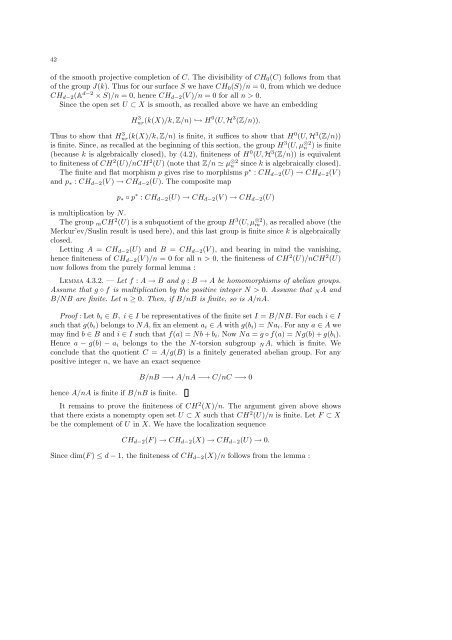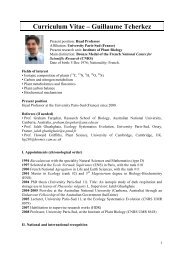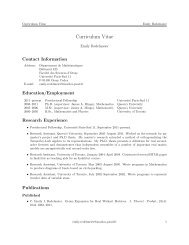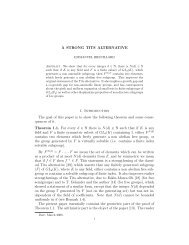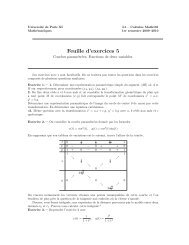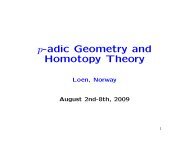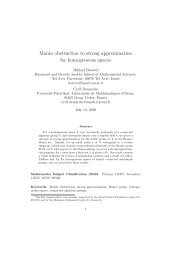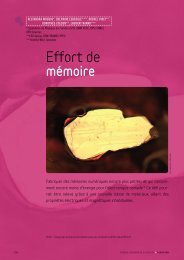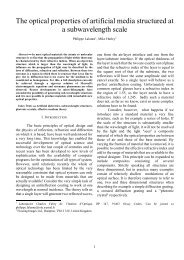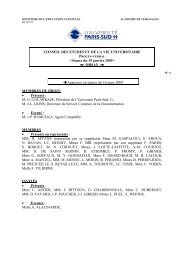Birational invariants, purity and the Gersten conjecture Lectures at ...
Birational invariants, purity and the Gersten conjecture Lectures at ...
Birational invariants, purity and the Gersten conjecture Lectures at ...
Create successful ePaper yourself
Turn your PDF publications into a flip-book with our unique Google optimized e-Paper software.
42<br />
of <strong>the</strong> smooth projective completion of C. The divisibility of CH 0 (C) follows from th<strong>at</strong><br />
of <strong>the</strong> group J(k). Thus for our surface S we have CH 0 (S)/n = 0, from which we deduce<br />
CH d−2 (A d−2 × S)/n = 0, hence CH d−2 (V )/n = 0 for all n > 0.<br />
Since <strong>the</strong> open set U ⊂ X is smooth, as recalled above we have an embedding<br />
H 3 nr(k(X)/k, Z/n) ↩→ H 0 (U, H 3 (Z/n)).<br />
Thus to show th<strong>at</strong> Hnr(k(X)/k, 3 Z/n) is finite, it suffices to show th<strong>at</strong> H 0 (U, H 3 (Z/n))<br />
is finite. Since, as recalled <strong>at</strong> <strong>the</strong> beginning of this section, <strong>the</strong> group H 3 (U, µ ⊗2<br />
n ) is finite<br />
(because k is algebraically closed), by (4.2), finiteness of H 0 (U, H 3 (Z/n)) is equivalent<br />
to finiteness of CH 2 (U)/nCH 2 (U) (note th<strong>at</strong> Z/n ≃ µ ⊗2<br />
n since k is algebraically closed).<br />
The finite <strong>and</strong> fl<strong>at</strong> morphism p gives rise to morphisms p ∗ : CH d−2 (U) → CH d−2 (V )<br />
<strong>and</strong> p ∗ : CH d−2 (V ) → CH d−2 (U). The composite map<br />
p ∗ ◦ p ∗ : CH d−2 (U) → CH d−2 (V ) → CH d−2 (U)<br />
is multiplic<strong>at</strong>ion by N.<br />
The group m CH 2 (U) is a subquotient of <strong>the</strong> group H 3 (U, µ ⊗2<br />
m ), as recalled above (<strong>the</strong><br />
Merkur’ev/Suslin result is used here), <strong>and</strong> this last group is finite since k is algebraically<br />
closed.<br />
Letting A = CH d−2 (U) <strong>and</strong> B = CH d−2 (V ), <strong>and</strong> bearing in mind <strong>the</strong> vanishing,<br />
hence finiteness of CH d−2 (V )/n = 0 for all n > 0, <strong>the</strong> finiteness of CH 2 (U)/nCH 2 (U)<br />
now follows from <strong>the</strong> purely formal lemma :<br />
LEMMA 4.3.2. — Let f : A → B <strong>and</strong> g : B → A be homomorphisms of abelian groups.<br />
Assume th<strong>at</strong> g ◦ f is multiplic<strong>at</strong>ion by <strong>the</strong> positive integer N > 0. Assume th<strong>at</strong> N A <strong>and</strong><br />
B/NB are finite. Let n ≥ 0. Then, if B/nB is finite, so is A/nA.<br />
Proof : Let b i ∈ B, i ∈ I be represent<strong>at</strong>ives of <strong>the</strong> finite set I = B/NB. For each i ∈ I<br />
such th<strong>at</strong> g(b i ) belongs to NA, fix an element a i ∈ A with g(b i ) = Na i . For any a ∈ A we<br />
may find b ∈ B <strong>and</strong> i ∈ I such th<strong>at</strong> f(a) = Nb + b i . Now Na = g ◦ f(a) = Ng(b) + g(b i ).<br />
Hence a − g(b) − a i belongs to <strong>the</strong> <strong>the</strong> N-torsion subgroup N A, which is finite. We<br />
conclude th<strong>at</strong> <strong>the</strong> quotient C = A/g(B) is a finitely gener<strong>at</strong>ed abelian group. For any<br />
positive integer n, we have an exact sequence<br />
hence A/nA is finite if B/nB is finite.<br />
B/nB −→ A/nA −→ C/nC −→ 0<br />
It remains to prove <strong>the</strong> finiteness of CH 2 (X)/n. The argument given above shows<br />
th<strong>at</strong> <strong>the</strong>re exists a nonempty open set U ⊂ X such th<strong>at</strong> CH 2 (U)/n is finite. Let F ⊂ X<br />
be <strong>the</strong> complement of U in X. We have <strong>the</strong> localiz<strong>at</strong>ion sequence<br />
CH d−2 (F ) → CH d−2 (X) → CH d−2 (U) → 0.<br />
Since dim(F ) ≤ d − 1, <strong>the</strong> finiteness of CH d−2 (X)/n follows from <strong>the</strong> lemma :


